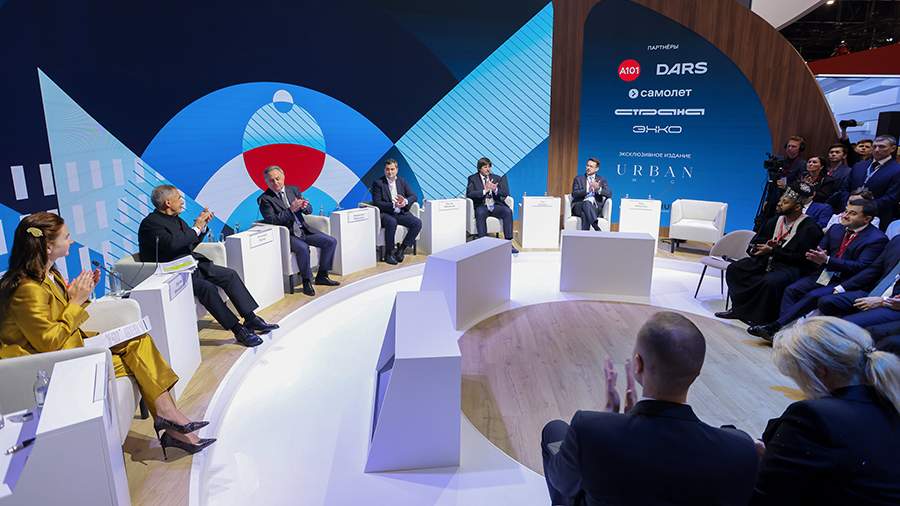The SPIEF spoke about the progress of the program for the restoration of cultural heritage sites
- Новости
- Local news
- The SPIEF spoke about the progress of the program for the restoration of cultural heritage sites

At the session "Legacy. Visionaries" experts discussed the implementation of the presidential program for the restoration of cultural heritage, the press service of DOM.RF reported. As the general director of the HOUSE said.Russian Federation Vitaly Mutko, a single fixed rate will be adopted to implement the program.
"It was decided to establish a single fixed preferential rate of no more than 9% for the restoration of cultural heritage sites in all regions of the country," Vitaly Mutko said on the sidelines of the forum.
Speaking at the SPIEF, he noted that starting in 2024, the HOUSE.The Russian Federation implements a preferential lending program, according to which investors can attract affordable debt financing. Loans at a rate of 6% with a key rate of 20% from the Bank of Russia are currently available for 24 windows from 8 pilot regions of Russia. Recently, it was decided to include the Kursk region in the program, which became the 9th region in the pilot.
"We are also working to shorten the investment and recovery cycle: today, when working with historical sites, it averages up to 7 years, and we plan to reduce it to 3 years," Mutko said. To do this, it is necessary to optimize the requirements and deadlines for passing examinations and other licensing procedures when working with such facilities. Such legislative initiatives are already being discussed with the Ministry of Construction, the Ministry of Culture and the expert community.
Another important step in the development of the program was the consolidation of the legal status of the heritage.dom.rf platform. On June 17, 2025, the relevant bill was adopted by the State Duma in the first reading. This will ensure that investors have access to complete and up-to-date information about facilities and their investment potential on a single Legacy platform through the integration of the resource with government information systems and registries. Managing Director of the HOUSE.Anatoly Azizov of the Russian Federation reported during the discussion "1000 stories of the future" that already today more than a thousand objects with a total area of more than 1 million square meters are placed on the platform. He noted that today all the information necessary for investors about federal, regional and municipal property, their current condition, as well as the status of the land on which they are located is also available there. The platform, as one of the tools for attracting and supporting investors, will shorten the customer journey at all stages of the implementation of restoration projects and the integration of restored facilities into the modern economy of the regions.
The session participants also discussed possible legislative changes aimed at increasing the interest of potential investors in the restoration of historical sites. Thus, in order to increase the attractiveness of projects for developers, the possibility of amending Federal Law No. 214-FZ and extending the mechanism for attracting funds from participants in shared-equity construction to adapt such facilities to multi-family residential buildings is being discussed. This will strengthen the trust of investors and shareholders, ensure transparency and security of investments in projects combining the preservation of cultural heritage and housing construction.
As Vitaly Mutko noted, another measure that increases investment attractiveness may be a change in 161-FZ, which provides for the possibility of combining restoration projects with land plots and other attractive lots.
During the session, Irek Fayzullin, Head of the Russian Ministry of Construction, spoke about approaches to preserving historical and cultural heritage sites and the need to find a balance between their preservation and the implementation of modern infrastructure solutions.
"The preservation of cultural heritage sites is a very urgent and serious task that needs to be approached carefully and competently. Cultural heritage sites where people live require major repairs and the participation of residents in these matters. The changes made to the regulatory framework made it possible to include more houses in the regional capital repair program," said Fayzullin.
The Minister also drew the attention of the expert community to the fact that an important element of involving cultural heritage sites in regional renovation and reconstruction programs is the synchronization of legislative bases in terms of urban planning, historical and cultural sphere and fire safety.
An example of such synchronization was the coordinated work of the Ministry of Construction of Russia, the Ministry of Culture of Russia and the Ministry of Emergency Situations on the restoration of the St. Petersburg Rimsky-Korsakov State Conservatory, which allowed the project to be completed in three years. Previously, in Russia, restoration of such a scale was not carried out in such a short time.
The session was also attended by the head of the Republic of Tatarstan, Chairman of the State Council of the Russian Federation Commission on Infrastructure for Life, Rustam Minnikhanov, Head of the Moscow Investment and Industrial Policy Department Vladislav Ovchinsky, Mayor of Tyumen Maxim Afanasyev, President of the Strana Development Group Alexander Gaidukov, Senator from the Lipetsk Region Evgeniya Uvarkina.
Переведено сервисом «Яндекс Переводчик»
